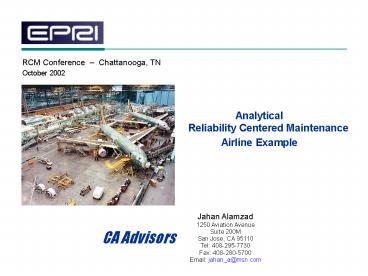Analytical Reliability Centered Maintenance - PowerPoint PPT Presentation
1 / 12
Title:
Analytical Reliability Centered Maintenance
Description:
... the unit cost of production and delivery Data Compilation RCM Operations Management Decision Support Enhanced Asset ... Electric Power Research ... – PowerPoint PPT presentation
Number of Views:969
Avg rating:3.0/5.0
Title: Analytical Reliability Centered Maintenance
1
RCM Conference Chattanooga, TN October 2002
- AnalyticalReliability Centered Maintenance
- Airline Example
Jahan Alamzad 1250 Aviation Avenue Suite
200M San Jose, CA 95110 Tel 408-295-7730 Fax
408-280-5700 Email jahan_a_at_msn.com
CA Advisors
2
Objectives
- Present applying Reliability-centered Maintenance
(RCM) to develop analytical decision-support
tools - Discuss analytical applications of RCM in the
airline industry - Provide a structure of developments
3
Overview
- RCM focuses on understanding reliability
characteristics - Reliability characteristics can be abstracted
analytically, and be represented by indicators - Decisions can then be based on such indicators,
providing significant benefits
Operations Management
Enhanced Asset Management
RCM
DecisionSupport
4
Decision-support tools
- Reliability indicators
- understand the inherent reliability of parts
- estimate failure rate
- evaluate aging features
- Forecasting
- predict maintenance events
- anticipate maintenance activities
- Planning
- determine maintenance workload and material
requirements during a specific period of time - strategic assessment of maintenance needs
- identify support resources
- Optimization
- right-size inventory requirements
- repairable parts
- expendable parts
- design optimal maintenance program
5
RCM airline industry
- Genesis of RCM
- pre-deregulation
- observing enhanced reliability of modern flight
equipment - better ways to capitalized on increased
performance - New philosophy
- condition monitoring vs. overhaul
- life-limited parts
- threshold-limited parts
- Regulatory control
- highly-regulated operations commercially
deregulated - must prove before modifying maintenance practices
- regulatory requirements and best practices
6
Federal Aviation Regulations (FARs)
- Must comply with FARs as a certificated air
carrier - Policing mechanism
- auditing
- code of honor
- Mostly concerned with MRO (maintenance-repair-over
haul) tracking and record-keeping - manufacturer information
- manufactured date
- time since manufactured (flying hours, cycles,
days) - time since overhaul/installation (flying hours,
cycles, days) - history tracking
- positive tracking
- compliance with maintenance program
- Maintenance activity record keeping
- Requires substantial information system
infrastructure to comply properly
RCM separation of data-processing and
decision-support
7
Significant benefits
- Ease of developing analytical decision-support
tools - Available data
- standard
- accessible
- Quality decisions
- identify performance criteria
- monitor performance
- evaluate practices
- next-generation flight equipment maintenance
- asset management
- Industry-wide analysis
- Living RCM
Performance
Unit Cost
8
Example engine maintenance
Engine Reliability System
Engine Removal Forecast
Spare Engine Planning System
Engine Life Optimizer
9
Structured approach
10
Pilot study October 2000
Probability of failure before t p
one-parameter approach
two-parameter approach
ln-ln scale
ln scale
Slope beta parameter
f(p)
f(p)
Slope failure rate
Characteristic Life
ln scale
t
t
- Analysis process
- identify Scheduled vs Unscheduled events
- determine inter-event time
- build probability distribution function (pdf)
- transform data points
- do regression analysis
- determine parameters
11
Results (one breaker model)
- One-parameter
- Failure rate 0.00149
- R-Squared 95.9
- Two-parameter
- Beta 1.06067
- Characteristic life 703.30
- R-Squared 98.0
- Application
- Input
- next scheduled maintenance 400 days
- time since last maintenance 120 days
- Output
- probability of failure beforescheduled
maintenance - expected time until next failure (days)
one-parameter
two-parameter
0.4488
0.4360
301
306
12
Implementation
- Living RCM allows developing decision-support
tools that reduce the unit cost of production and
delivery
Unit Cost
Overage
Shortage
Resource Level
- Needed resources can be scientifically justified
and decisions can be analytically supported
- Requires industry-wide data standardization
- Significant and immediate benefits
- better planning
- best practices































